Visual Regression Testing of OBIEE with PhantomCSS
Earlier this year I wrote a couple of blogs posts (here and here) discussing the topic of automated Regression Testing and OBIEE. One of the points that I was keen make was that OBIEE is a stack of elements and depending on the change being tested, it may be sensible to focus on certain elements in the stack instead of all of it. For example, if you are changing the RPD, there is little value in doing a web-based test when you can actually test for the vast majority of regressions using the nqcmd tool alone.
I also argued that testing the front end of OBIEE using tools such as Selenium is difficult to do comprehensively, it can be inflexible, time-consuming and in some cases just not a sensible use of effort. These tools work around the idea of parsing the web page that is served up and checking for presence (or absence) of a particular piece of text or an element on a web page. So for example, you could run a test and tell it to fail if it finds the text “Error” on the page, or you could say only pass the test if some known-content is present, such as a report title or data figure. This type of testing is prone to a great deal of false-negatives, because to efficiently build any kind of test case you must focus on something to check for in the page, but you cannot code for every possible error or failure. It is also usually based heavily on the internal IDs of elements on the page in locating the 'something' to check for. As the OBIEE Document Object Model (DOM) is undocumented code, Oracle are at presumably at liberty to change it whenever they feel like it, and thus any tests written based on it may fail. Finally, OBIEE 11g still defaults to serving up graphs as Flash objects, which Selenium et al just cannot handle, and so cannot be tested.
So, what do we do about regression testing the OBIEE front end?
What do we need to test in the front end?
There is still a strong case for regression testing the OBIEE front end. Analyses get changed, Dashboards break, permissions are updated - all these things can cause errors or problems for the end user, but which are something that testing further down the OBIEE stack (using something like nqcmd) will not cover.
Consider a simple dashboard:
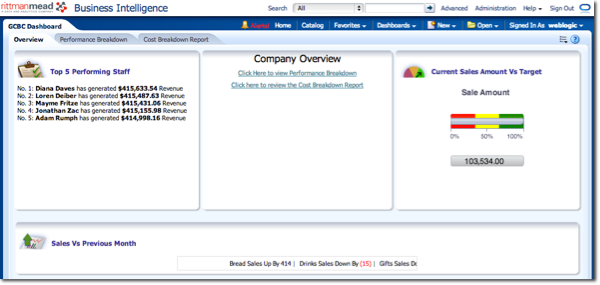
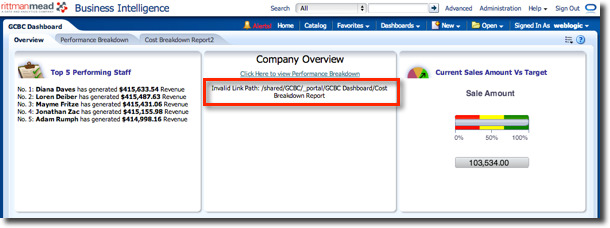
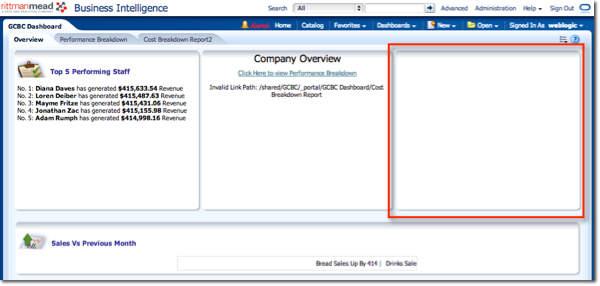
Another thing that is important to check in the front end is that authorisations are enforced as they should be. That is, a user can see the dashboards that they should be able to, and that they cannot see the ones they're not. Changes made in the LDAP directory holding users and their groups, or a configuration change in the Application Roles, could easily mean that a user can no longer see the dashboards they should be able to. We could code for this specific issue using something like Web Services to programatically check each and every actual permission - but that could well be overkill.
What I would like to introduce here is the idea of testing OBIEE for regressions visually - but automated, of course.
Visual Regression Testing
Driven by the huge number of applications that are accessed solely on the web (sorry, “Cloud”), a new set of tools have been developed to support the idea of testing web pages for regressions visually. Instead of ‘explaining’ to the computer specifically what to look for in a page (no error text, etc), visual regression testing uses a process to compare images of a web page, comparing a baseline to a sample taken afterwards. This means that the number of false-negatives (missing genuine errors because the test didn’t detect them) drops drastically because instead of relying on coding a test program to parse the Document Object Model (DOM) of an OBIEE web page (which is extremely complex), instead it is simply considering if two snapshots of the resulting rendered page look the same.
The second real advantage of this method is that typically the tools (including the one I have been working with and will demonstrate below, PhantomCSS) are based on the actual engine that drives the web browsers in use by real end-users. So it’s not a case of parsing the HTML and CSS that the web server sends us and trying to determine if there’s a problem or not - it is actually rendering it the same as Chrome etc and taking a snapshot of it. PhantomCSS uses PhantomJS, which uses the engine that Safari is built on, WebKit.
Let’s Pretend…
So, we’ve got a tool - that I’ll demonstrate shortly - that can programatically fetch and snapshot OBIEE pages, and compare the snapshots to check for any changes. But what about graphs rendered in flash? These are a blindspot usually. Well here we can be a bit cheeky. If you pretend (in the User-Agent HTTP request header) to be an iPhone or iPad (devices that don’t support flash) then OBIEE obligingly serves up PNG graphs plus some javascript to do the hover tooltips. Because it’s a PNG image that means that it will be rendered correctly in our “browser”, and so included in the snapshot for comparison.
CasperJS
Let’s see this scripting in action. Some clarification of the programs we’re going to use first:
- PhantomJS is the core functionality we’re using, a headless browser sporting Javascript (JS) APIs
- CasperJS provides a set of APIs on top of PhantomJS that make working with web page forms, navigation etc much easier
- PhantomCSS provides the regression testing bit, taking snapshots and running code to compare them and report differences.
We'll consider a simple CasperJS example first, and come on to PhantomCSS after. Because PhantomCSS uses CasperJS for its core interactions, it makes sense to start with the basics.
Here is a bare-bones script. It loads the login page for OBIEE, echoes the page title to the console, takes a snapshot, and exits:
var casper = require('casper').create();
casper.start('http://rnm-ol6-2:9704/analytics', function() {
this.echo(this.getTitle());
this.capture('casper_screenshots/login.png');
});
casper.run();
I run it from the command line:
$ casperjs casper_example_01.js Oracle Business Intelligence Sign In $
As you can see, it outputs the title of the page, and then in the screenshots folder I have this:
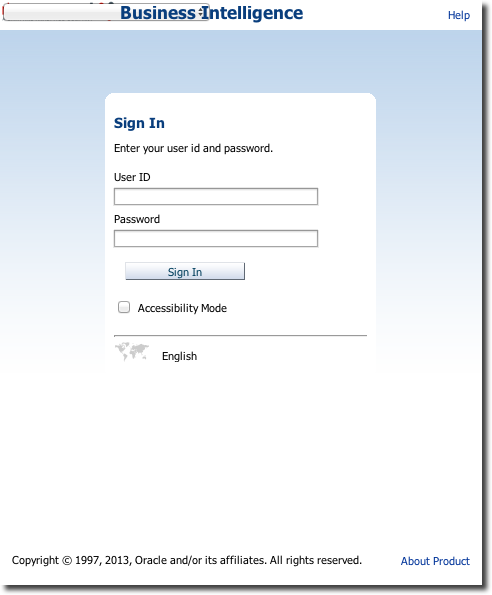
Now, let’s build a bit of a bigger example, where we login to OBIEE and see what dashboards are available to us:
// Set the size of the browser window as part of the
// Casper instantiation
var casper = require('casper').create({viewportSize: {
width: 800,
height: 600
}});
// Load the login page
casper.start('http://rnm-ol6-2:9704/analytics', function() {
this.echo(this.getTitle());
this.capture('casper_screenshots/login.png');
});
// Do login
casper.then(function(){
this.fill('form#logonForm', { NQUser: 'weblogic' ,
NQPassword: 'Password01'
}, true);
}).
waitForUrl('http://rnm-ol6-2:9704/analytics/saw.dll?bieehome',function(){
this.echo('Logged into OBIEE','INFO')
this.capture('casper_screenshots/afterlogin.png');
});
// Now "click" the Dashboards menu
casper.then(function() {
this.echo('Clicking Dashboard menu','INFO')
casper.click('#dashboard');
this.waitUntilVisible('div.HeaderPopupWindow', function() {
this.capture('casper_screenshots/dashboards.png');
});
});
casper.run();
So I now get a screenshot of after logging in:
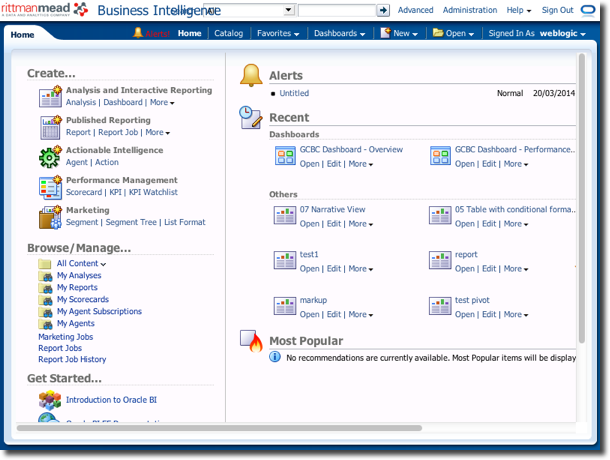
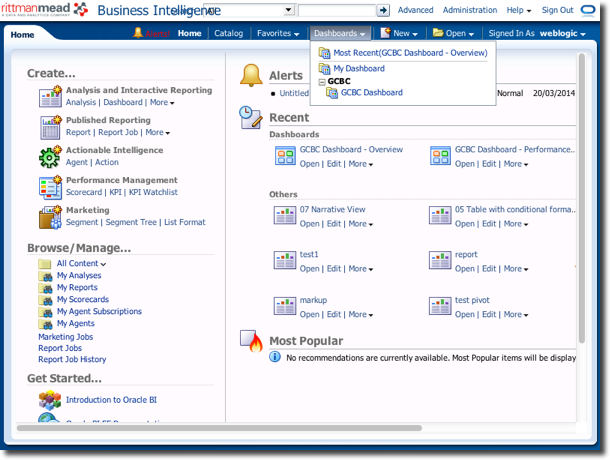
waitUntilVisible function, which is crucial for making sure that the page has rendered fully. For a user clicking the menu, they’d obviously wait until it appears but computers work much faster so functions like this are important for reining them back.
To round off the CasperJS script, let’s add to the above navigating to a Dashboard, snapshotting it (with graphs!), and then logging out.
[...]
casper.then(function(){
this.echo('Navigating to GCBC Dashboard','INFO')
casper.clickLabel('GCBC Dashboard');
})
casper.waitForUrl('http://rnm-ol6-2:9704/analytics/saw.dll?dashboard', function() {
casper.waitWhileVisible('div.AjaxLoadingOpacity', function() {
casper.waitWhileVisible('div.ProgressIndicatorDiv', function() {
this.capture('casper_screenshots/dashboard.png');
})
})
});
casper.then(function() {
this.echo('Signing out','INFO')
casper.clickLabel('Sign Out');
});
Again, there’s a couple of waitWhileVisible functions in there, necessary to get CasperJS to wait until the dashboard has rendered properly. The dashboard rendered is captured thus:
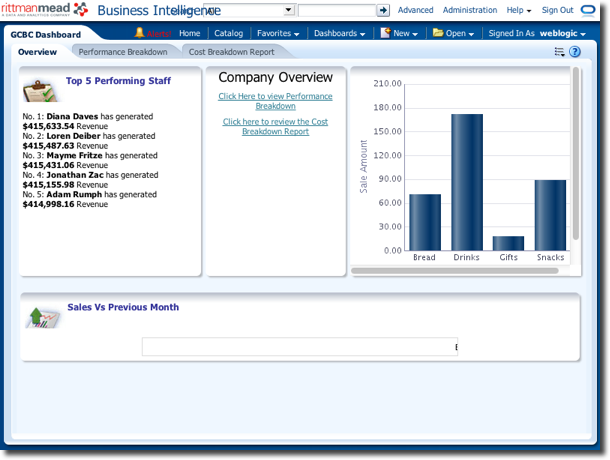
PhantomCSS
So now let’s see how we can use the above CasperJS code in conjunction with PhantomCSS to generate a viable regression test scenario for OBIEE.
The script remains pretty much the same, except CasperJS’s capture gets replaced with a phantomcss.screenshot based on an element (html for the whole page), and there’s some extra code “footer” to include that executes the actual test.
So let’s see how the proposed test method holds up to the examples above - broken links and disappearing reports.
First, we run the baseline capture, the “known good”. The console output shows that this is the first time it’s been run, because there are no existing images against which to compare:
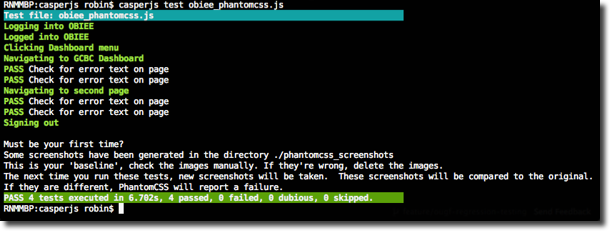
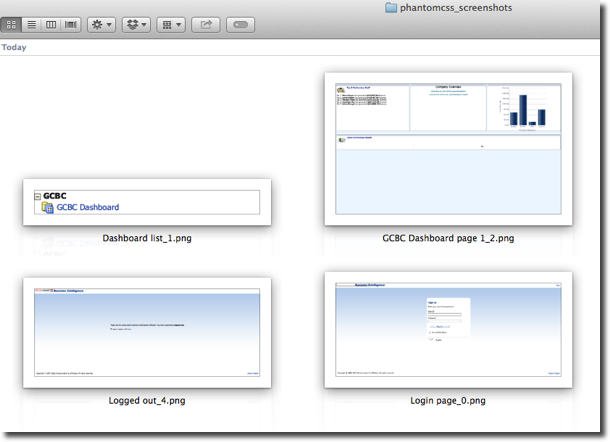
Now I run the same PhantomCSS test again, and this time it tells me there’s a problem:
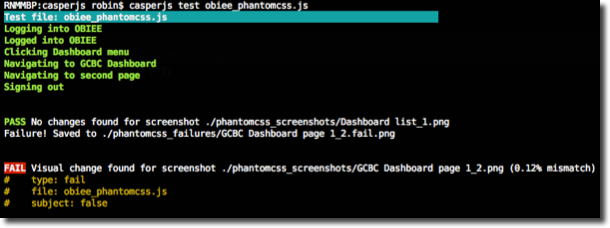

Again, PhantomCSS picks up the difference, and highlights it nice and clearly in the generated image:

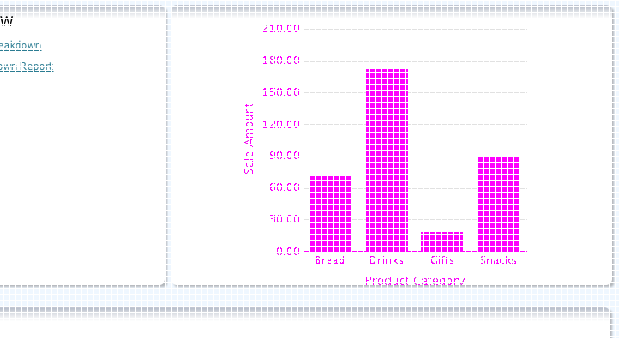
Belts and Braces?
So visual regression testing is a great thing, but I think a hybrid approach, of parsing the page contents for text too, is worthwhile. CasperJS provides its own test APIs (which PhantomCSS uses), and we can write simple tests such as the following:
this.test.assertTextDoesntExist('Invalid Link Path', 'Check for error text on page');
this.test.assertTextDoesntExist('View Display Error', 'Check for error text on page');
phantomcss.screenshot('div.DashboardPageContentDiv','GCBC Dashboard page 1');
So check for a couple of well-known errors, and then snapshot the page too for subsequent automatic comparison. If an assertion is failed, it shows in the console:

Frame of Reference
The eagle-eyed of you will have noticed that the snapshots generated by PhantomCSS above are not the entire OBIEE webpage, whereas the ones from CasperJS earlier in this article are. That is because PhantomCSS deliberately wants to focus on an area of the page to test, identified using a CSS3 selector. So if you are testing a dashboard, then considering the toolbar is irrelevant and can only lead to false-positives.
phantomcss.screenshot('div.DashboardPageContentDiv','GCBC Dashboard page 1');
Similarly, considering the available dashboard list (to validate enforced authorisations) just needs to look at the list itself, not the rest of the page. (and yes, that does say "Protals" - even developers have fat fingers sometimes ;-) )
phantomcss.screenshot('div.HeaderSharedProtals','Dashboard list');
Using this functionality means that the generated snapshots used for comparison can be done to exclude things like the alerts bar (which may appear or disappear between tests).
The Devil's in the Detail
I am in no doubt that the method described above has definitely got its place in the regression testing arsenal for OBIEE. What I am yet to be fully convinced of is quite to what extent. My beef with Selenium et al is the level of detail one has to get in to when writing tests - identifying strings to test for, their location in the DOM, and so on. Yet above in my CasperJS/PhantomCSS examples, I have DOM selectors too, so is this just the same problem? At the moment, I don't think so. For Selenium, to build a comprehensive test, you have to dissect the DOM for every single test you want to build. Whereas with CasperJS/PhantomCSS I think there is the need to write a basic framework for OBIEE (the basics of which are provided in this post; you're welcome), which can then be parameterised based on dashboard name and page only. Sure, additional types of tests may need new code, but it would be more reusable.
Given that OBIEE doesn't come with an out of the box test rig, whatever we build to test it is going to be bespoke, whether its nqcmd, Selenium, JMeter, LoadRunner, OATS, QTP, etc etc -- the smart money is picking the option that will be the most flexible, more scalable, easiest to maintain, and take the least effort to develop. There is no one "program to rule them all" - an accurate, comprehensive, and flexible test suite is invariably going to utilise multiple components focussing on different areas.
In the case of regression testing – what is the aim of the testing? What are you looking to validate hasn't broken after what kind of change? If all that’s changed in the system is the DBAs adding some indexes or partitioning to the data, I really would not be going anywhere near the front end of OBIEE. However, more complex changes affecting the Presentation Catalog and the RPD can be well covered by this technique in conjunction with nqcmd. Visual regression testing will give you a pass/fail, but then it’s up to you to decipher the images, whereas nqcmd will give you a pass/fail but also an actual set of data to show what has changed.
Don't forget that other great tool -- you! Or rather, you and your minions, who can sit at OBIEE for 5 minutes and spot certain regressions that would take magnitudes of order greater in time to build a test to locate. Things like testing for UI/UX changes between OBIEE versions is something that is realistically handled manually. The testing of the dashboards can be automated, but faster than I can even type the requirement, let alone build a test to validate it - does clicking on the save icon bring up the save box? Well go click for yourself - done? Next test.
Summary
I have just scratched the surface of what is possible with headless browser scripting for testing OBIEE. Being able to automate and capture the results of browser interactions as we've seen above is hugely powerful. You can find the CasperJS API reference here if you want to find out more about how it is possible to interact with the web page as a "user".
I’ve put the complete PhantomCSS script online here. Let me know in the comments section or via twitter if you do try it out!
Thanks to Christian Berg and Gianni Ceresa for reading drafts of this article and providing valuable feedback.
